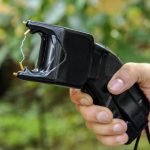Police Taser 12-Year Old Boy in the Back

Northern Territory police have come under fire for using a taser on a 12-year old boy, and for their use of tasers on children generally.
The Incident
The NT Ombudsman has requested a briefing from police after they tasered the boy at a petrol station in Palmerston last week.
According to police, the boy and two teenagers aged 13 and 15 were driving erratically in a stolen car, causing the vehicle to lose traction. Police spotted the trio at the service station and tasered the 12-year old in the back as he attempted to flee.
“He was screaming and shouting, he was obviously in pain” a witness said. “He just stopped in his tracks and just went down”, and police then “jumped on top of him” and handcuffed him.
The boy was then been charged with aggravated unlawful use of a motor vehicle and escaping lawful custody.
Political Response
NT Chief Minister Michael Gunner said the use of a taser in those circumstances was “not ideal”.
However, he proceeded to point out that police are required to make split second decisions in heated situations, and that the incident must be viewed in that context.
Police Protocols
Strict guidelines have been developed for the use of tasers in Australia.
In New South Wales, a taser is only meant to be discharged after a “proper assessment of the situation and environment” are undertaken, and the use of the weapon is necessary to:
- Protect human life;
- Protect an officer or others where violent confrontation or violent resistance is occurring or imminent;
- Protect an officer in danger of being overpowered, or to protect themselves or another person from the risk of actual bodily harm; or
- Protect against animals.
Police guidelines also state that taser use is discretional, and an assessment must be made by the discharging officer as to whether the device “is the best option for the situation having regard to the Criteria to Discharge a Taser and the Taser training they have received.”
Use on Children
Strikingly absent from the guidelines, however, is any reference to the use of tasers on children over the age of 10.
Indeed, the criteria applied to children over 10 is the same as for adults, despite warnings by manufacturers not to use the weapons on children.
Former police minister Michael Gallacher has defended the omission, saying “It is hard to ask age when someone is running at you with a knife.”
Dangers of Tasers
Those struck by tasers typically experience strong involuntary muscle contractions.
Taser International, a major manufacturer of the devices, warns that tasers can cause “physiological and/or metabolic effects that may increase the risk of death or serious injury,” and use near the chest of children can cause extra heartbeats, or cardiac capture, which is more likely to be fatal in children due to their size.
The UK conducted extensive research on the effects of tasers on children, after it was revealed that tasers were being used on under-18s in Britain almost daily. Official guidance from the Association of Chief Police Officers subsequently confirmed that children are “at potentially greater risk from the cardiac effects of Taser currents than normal adults of average or large stature”.
The dangers of tasers can be increased in certain scenarios, such as where the subject has health problems, drugs or alcohol in their system or where the device is administered to the chest.
Criticism of Police Discretion
Between 2008 and 2013, tasers were deployed against children 149 times in NSW alone, with the youngest subject being just 10-years old.
A recent report by the NSW Ombudsman found that police breached taser guidelines in 14% of cases over a two year period. Over a quarter of those incidents involved the use of tasers “in either probe or drive-stun mode when they should not have been.”
Anna Brown, a solicitor with the Human Rights Law Centre, believes the death of Brazilian student Roberto Curti – who was 21 when he died after being hit by numerous taser shots in February last year – highlights the fact tasers can indeed be deadly. She has called for police to enact stricter controls on their use on children.
“We are talking about weapons that are highly dangerous and there should be extreme limitations and warnings when it comes to certain groups like young people, the elderly and pregnant women,” Ms Brown said.







